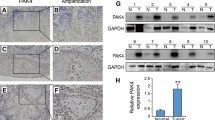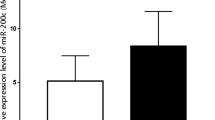Abstract
Although RAD21 is involved in the repair of double-strand breaks in DNA and is essential for mitotic growth, its role in cancer has been unclear. In this study, the relevance of RAD21 gene expression to the invasion and metastasis of oral squamous cell carcinoma was clarified using laser microdissection and real-time polymerase chain reaction (PCR). Using two different metastatic potential oral squamous cells [high-metastatic-potential squamous cell carcinoma cells (SAS-Ly) and low-metastatic-potential squamous cell carcinoma cells (SAS)], the relation of RAD21 gene expression to apoptosis, invasion, and metastasis was examined. The results showed that RAD21 gene expression was significantly decreased in oral squamous cell carcinoma when it expressed the INFβ and INFγ invasion patterns in comparison with the INFα invasion pattern (p<0.01). In addition, in comparison with SAS cells, SAS-Ly cells indicated tolerance to cell death induced by an apoptosis induction reagent, while the expression level of the RAD21 gene in SAS cells was increased by the apoptosis induction reagent. However, in SAS-Ly cells, the reagent induced no significant difference. Our findings indicate that the RAD21 gene was closely related to the invasion and metastasis of cancer cells.






Similar content being viewed by others
Abbreviations
- DEPC:
-
Dietyl pyrocarbonate
References
Acs G, Zhang PJ, Rebbeck TR, Acs P, Verma A (2002) Immunohistochemical expression of erythropoietin and erythropoietin receptor in breast carcinoma. Cancer 95:969–981
Aida T, Irie T, Tachikawa T (2001) Establishment and characterization of human oral squamous cell carcinoma cell line with highly lymph node metastatic potential. J Jpn Soc Oral Tumor 13:301–306
Atalay A, Crook T, Ozturk M, Yulug IG (2002) Identification of genes induced by BRCA1 in breast cancer cells. Biochem Biophys Res Commun 299:839–846
Baba H, Ohshiro T, Yamamoto M, Endo K, Adachi E, Kakeji Y, Kohnoe S, Maehara Y, Sugimachi K (1997) Clinicopathological characteristics of stage 1 gastric cancer: comparison of macroscopic and microscopic findings. Hepatogastroenterology 44:554–558
Baek JH, Jang JE, Kang CM, Chung HY, Kim ND, Kim KW (2000) Hypoxia-induced VEGF enhances tumor survivability via suppression of serum deprivation-induced apoptosis. Oncogene 19:4621–4631
Beavon IR (1999) Regulation of E-cadherin: does hypoxia initiate the metastatic cascade? Mol Pathol 52:179–188
Beavon IR (2000) The E-cadherin–catenin complex in tumour metastasis: structure, function and regulation. Eur J Cancer 36:1607–1620
Birkenbihl RP, Subramani S (1992) Cloning and characterization of rad21, an essential gene of Schizosaccharomyces pombe involved in DNA double-strand-break repair. Nucleic Acids Res 20:6605–6611
Birkenbihl RP, Subramani S (1995) The rad21 gene product of Schizosaccharomyces pombe is a nuclear, cell cycle-regulated phosphoprotein. J Biol Chem 270:7703–7711
Brizel DM, Scully SP, Harrelson JM, Layfield LJ, Bean JM, Prosnitz LR, Dewhirst MW (1996) Tumor oxygenation predicts for the likelihood of distant metastases in human soft tissue sarcoma. Cancer Res 56:941–943
Brizel DM, Sibley GS, Prosnitz LR, Scher RL, Dewhirst MW (1997) Tumor hypoxia adversely affects the prognosis of carcinoma of the head and neck. Int J Radiat Oncol Biol Phys 38:285–289
Cairns RA, Kalliomaki T, Hill RP (2001) Acute (cyclic) hypoxia enhances spontaneous metastasis of KHT murine tumors. Cancer Res 61:8903–8908
Chen F, Kamradt M, Mulcahy M, Byun Y, Xu H, McKay MJ, Cryns VL (2002) Caspase proteolysis of the cohesin component RAD21 promotes apoptosis. J Biol Chem 277:16775–16781
Dong Z, Wang JZ, Yu F, Venkatachalam MA (2003) Apoptosis-resistance of hypoxic cells: multiple factors involved and a role for IAP-2. Am J Pathol 163:663–671
Graeber TG, Osmanian C, Jacks T, Housman DE, Koch CJ, Lowe SW, Giaccia AJ (1996) Hypoxia-mediated selection of cells with diminished apoptotic potential in solid tumours. Nature 379:88–91
Hauf S, Waizenegger IC, Peters JM (2001) Cohesin cleavage by separase required for anaphase and cytokinesis in human cells. Science 293:1320–1323
Hirano T (2000) Chromosome cohesion, condensation, and separation. Annu Rev Biochem 69:115–144
Hoque MT, Ishikawa F (2001) Human chromatid cohesin component hRad21 is phosphorylated in M phase and associated with metaphase centromeres. J Biol Chem 276:5059–5067
Irie T, Tsutiya R, Yamamoto G, Maeda Y, Tachikawa T (2000) Expression analysis of mRNAs in oral squamous cell carcinoma using laser microdissection (laser pressure cell transfer type) and semiquantitative RT-PCR. J Showa Univ Dent Soc 21:75–81
Japanese Research Society for Gastric Cancer (1995) Japanese classification of gastric carcinoma, first English edition. Kanehara, Tokyo
Japanese Research Society for Corolectal Cancer (1995) Japanese classification of colorectal carcinoma, first English edition. Kanehara, Tokyo
Kumagai S, Kojima S, Imai K, Nakagawa K, Yamamoto E, Kawahara E, Nakanishi I (1994) Immunohistologic distribution of basement membrane in oral squamous cell carcinoma. Head Neck 16:51–57
Michaelis C, Ciosk R, Nasmyth, K (1997) Cohesins: chromosomal proteins that prevent premature separation of sister chromatids. Cell 91:35–45
Nasmyth K, Peters JM, Uhlmann F (2000) Splitting the chromosome: cutting the ties that bind sister chromatids. Science 288:1379–1385
Nishida T, Tanaka S, Haruma K, Yoshihara M, Sumii K, Kajiyama G (1995) Histologic grade and cellular proliferation at the deepest invasive portion correlate with the high malignancy of submucosal invasive gastric carcinoma. Oncology 52:340–346
Pati D, Zhang N, Plon SE (2002) Linking sister chromatid cohesion and apoptosis: role of Rad21. Mol Cell Biol 22:8267–8277
Porkka KP, Tammela TL, Vessella RL, Visakorpi T (2004) RAD21 and KIAA0196 at 8q24 are amplified and overexpressed in prostate cancer. Genes Chromosomes Cancer 39:1–10
Riedel F, Gotte K, Bergler W, Hormann K (2001) Inverse correlation of apoptotic and angiogenic markers in squamous cell carcinoma of the head and neck. Oncol Rep 8:471–476
Schwickert G, Walenta S, Sundfor K, Rofstad EK, Mueller-Klieser W (1995) Correlation of high lactate levels in human cervical cancer with incidence of metastasis. Cancer Res 55:4757–4759
Sonoda E, Matsusaka T, Morrison C, Vagnarelli P, Hoshi O, Ushiki, T, Nojima K, Fukagawa T, Waizenegger IC, Peters JM, Earnshaw WC, Takeda S (2001) Scc1/Rad21/Mcd1 is required for sister chromatid cohesion and kinetochore function in vertebrate cells. Dev Cell 1:759–770
Sook Kim M, Hyen Baek J, Bae MK, Kim KW (2001) Human rad21 gene, hHR21(SP), is downregulated by hypoxia in human tumor cells. Biochem Biophys Res Commun 281:1106–1112
Takahashi K, Kanazawa H, Akiyama Y, Tazaki S, Takahara M, Muto T, Tanzawa H, Sato K (1989) Establishment and characterization of a cell line (SAS) from poorly differentiated human squamous cell carcinoma of the tongue. J Jpn Stomatol Soc 38:20–28
Uhlmann F, Lottspeich F, Nasmyth K (1999) Sister-chromatid separation at anaphase onset is promoted by cleavage of the cohesin subunit Scc1. Nature 400:37–42
Volm M, Koomagi R (2000) Hypoxia-inducible factor (HIF-1) and its relationship to apoptosis and proliferation in lung cancer. Anticancer Res 20:1527–1533
Acknowledgements
This work was supported in part by the Showa University Grant-in-Aid for Innovative Collaborative Research Projects, the High-Technology Research Center Project and Characteristic Education from the Ministry of Education, Culture, Sports, Science and Technology of Japan.
Author information
Authors and Affiliations
Corresponding author
Rights and permissions
About this article
Cite this article
Yamamoto, G., Irie, T., Aida, T. et al. Correlation of invasion and metastasis of cancer cells, and expression of the RAD21 gene in oral squamous cell carcinoma. Virchows Arch 448, 435–441 (2006). https://doi.org/10.1007/s00428-005-0132-y
Received:
Accepted:
Published:
Issue Date:
DOI: https://doi.org/10.1007/s00428-005-0132-y




